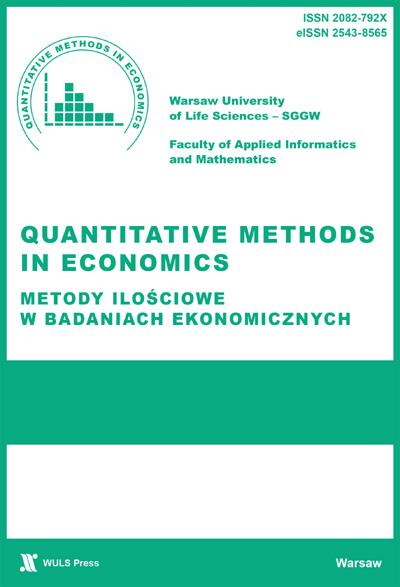On application of Newton’s Method to solve optimization problems in the consumer theory. Expansion’s Paths and Engel Curves
Main Article Content
Abstrakt
The paper continues investigations concerned with numerical modeling of the neoclassical theory of consumption begun in our previous paper [Strasburger et al. (2009)] This time we are interested in expansion’s paths and Engel curves for separable utility functions.. The used numerical procedure is based on Newton’s approximation method, implemented in the MATLAB environment. Based on the prior determination of the approximate solutions of the optimum problem we determine in this paper the expansion paths and Engel curves and compare them with their standard form studied in econometrics
Article Details
Jak cytować
Strasburger, A., & Zembrzuski, A. (2011). On application of Newton’s Method to solve optimization problems in the consumer theory. Expansion’s Paths and Engel Curves. Metody Ilościowe W Badaniach Ekonomicznych, 12(1), 135–146. Pobrano z https://qme.sggw.edu.pl/article/view/3104
Statystyki
Downloads
Download data is not yet available.
Rekomendowane teksty
Inne teksty tego samego autora
- Maciej Janowicz, Andrzej Zembrzuski, Symmetry Properties of Modified Black-Scholes Equation , Metody Ilościowe w Badaniach Ekonomicznych: Tom 22 Nr 2 (2021)
- Maciej Janowicz, Andrzej Zembrzuski, SIMULATION OF PARTICLE SWARM OPTIMIZATION FOR INVESTMENTS ON STOCK MARKET , Metody Ilościowe w Badaniach Ekonomicznych: Tom 21 Nr 4 (2020)
- Aleksander Strasburger, Olga Zajkowska, WHO WANTS TO WORK LONGER? , Metody Ilościowe w Badaniach Ekonomicznych: Tom 14 Nr 2 (2013)
- Aleksander Strasburger, Wacława Tempczyk, Teoretyczne podstawy metody Newtona przybliżonego rozwiązywania równań nieliniowych , Metody Ilościowe w Badaniach Ekonomicznych: Tom 12 Nr 2 (2011)
Licencja
Publikowane artykuły dostępne są na warunkach Open Access na zasadach licencji Creative Commons CC BY-NC – do celów niekomercyjnych udostępnione materiały mogą być kopiowane, drukowane i rozpowszechniane. Autorzy ponoszą opłatę za opublikowanie artykułu.

